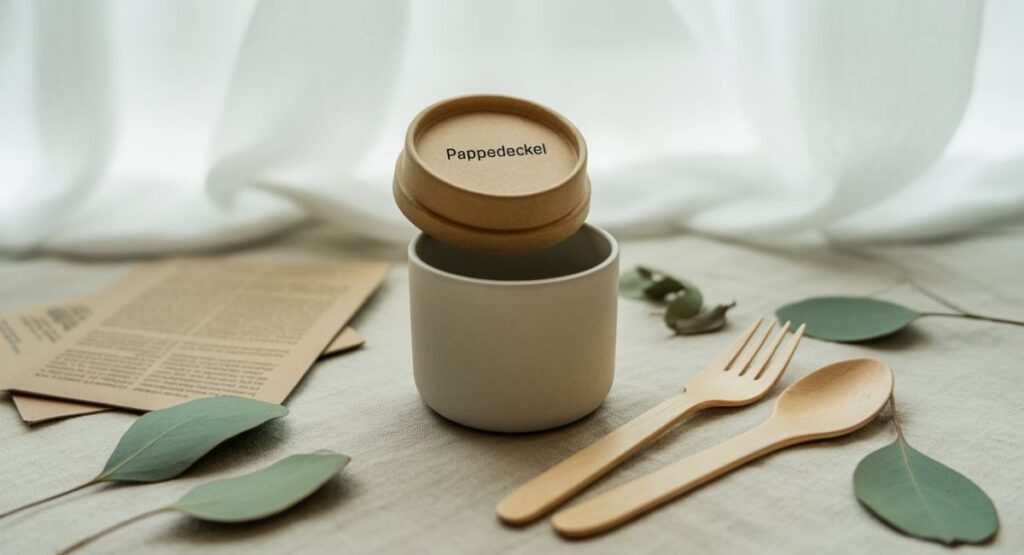Imagine that you’re holding a hot cup of coffee ready to go. The cup is boiling hot your hands are getting hot as you try to balance it all while opening your door. Imagine the thin, flat lid sliding over the cup to protect your hands from spills, and doing it in a way that leaves virtually no trace. This is the humble pappedeckel motion.
Although the name may sound odd (it is derived from German pappe which means cardboard and Deckel means lid) The concept behind pappedeckel has a profound significance to sustainability, innovation in packaging and everyday convenience. Through this post, readers will find out the definition of a pappedeckel and why it’s important as well as how it’s constructed and even how you can make your own version at home, or in small business use.
- What Exactly Is a Pappedeckel?
- Why the Pappedeckel Matters
- Brief History & Cultural Context
- How a Pappedeckel Is Made: Step-by-Step
- Real-World Anecdotes
- Step-by-Step: How to Prototype Your Own Pappedeckel
- Applications & Use Cases
- Challenges & How to Overcome Them
- Trends, Innovation, and the Future
- SEO & Semantic Keywords to Help You Search
- Conclusion
- FAQs
What Exactly Is a Pappedeckel?
The simplest definition of it is a cover or lid constructed from paperboard or cardboard. It could also be:
- flat or slightly rounded
- rectangular, round or a custom-designed shape
- Uncoated or lightly coated with a biodegradable coating
- Plain, print, printed with logos or QR codes or messages
In contrast to typical foam or plastic lids, pappedeckel can be composted and recyclable. They are often constructed from recycled fibers. They can be used as lightweight seals for jars, cups, containers as well as packaging boxes. Since they’re mostly made of paper they are more natural in their degradation and help reduce the amount of the amount of plastic waste. (See more information on green packaging options./)
Why the Pappedeckel Matters
Environmental Benefits
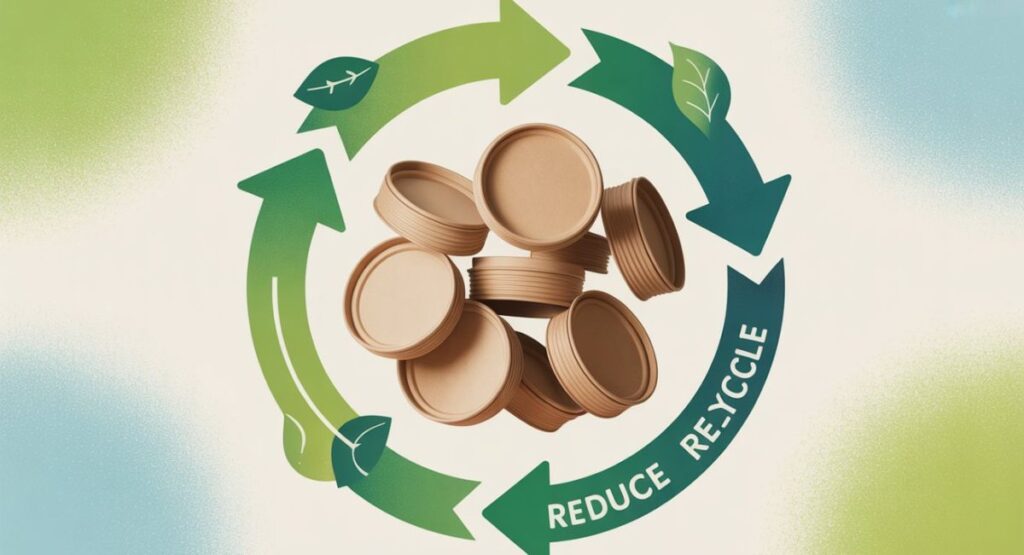
One of the primary reasons why people choose the pappedeckel is due to their ecological friendliness. Plastic lids are known for their long-lasting use on the planet In contrast cardboard lids break down more quickly and are able to are able to enter recycling streams for paper much more easily. This helps reduce the burden on landfills and reduces the need for fossil fuels.
Additionally, many pappedeckel items are made from recycled or FSC-certified papers that promotes sustainable forest management. In some of the most innovative designs biodegradable coatings are substituted for plastic films, so that the whole lid is compostable.
Cost & Practical Benefits
Although it is light an aesthetically-designed pappedeckel can be extremely durable. It is strong enough to stand up to transportation, handling and even moderate humidity (if it is coated). For commercial use lids made of cardboard, they typically cost much less than plastic and specially designed lids made of polymer, especially when used in large quantities.
Additionally, since they’re thin also, they occupy less space for storage and shipping. This results in lower emissions and lower logistics expenses. Their flat design lets businesses stack them up tightly which saves storage space.
Branding & Marketing Potential
Because pappedeckel have a printed surface, they can be used as a canvas to brand. A café could print its logo, its social handles for media, or an eco-friendly message directly on the lid. This transforms a common product into a sophisticated marketing instrument.
If you include the QR code or web-based link on the lid, consumers are able to scan it and find out more about your practices for sustainability and special promotions and menu options. This type of “smart packaging” leverages even small areas to engage customers.
Brief History & Cultural Context
The idea of covering containers using lids is not new however the use of paperboard or cardboard lids became popular with the advent of disposable consumer culture during the early 20th century.
Germany has a long history of efficient recycling processes and environmental regulations. The use of cardboard lids as an alternative to plastic was an ideal fit for companies seeking to reduce their garbage. As time passed, pappedeckel extensions into take-out containers, cafes and jar lids became more frequent as awareness of environmental issues increased.
Incredibly, even though pappedeckel is a term that is used in everyday life but the exact term (or variations) is being used online to be an “nonsense word” used when people forget the name or word. This linguistic twist demonstrates the way this word has caught the attention of the public beyond its literal definition.
How a Pappedeckel Is Made: Step-by-Step
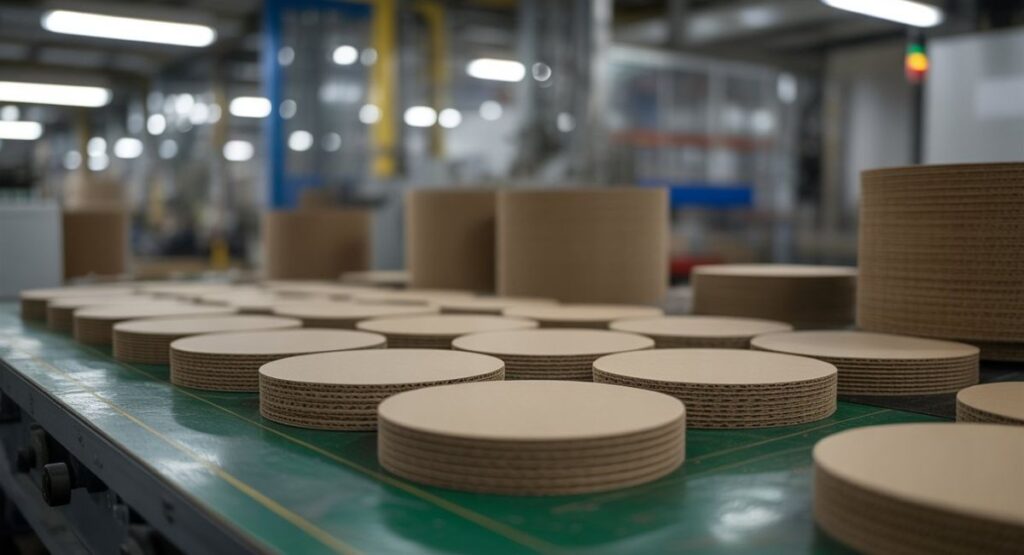
Here’s a quick overview of the way that manufacturers usually produce the pappedeckel
- Raw Material Sourcing
They start with cardboard or paperboard pulp typically using recycled fibers. Certifications such as FSC or PEFC guarantee an environmentally responsible forest. - Sheet Preparation
The pulp is shaped into sheets of the required thickness and uniformity. The moisture is removed to help stabilize the board. - Die Cutting / Shaping
Sheets of large size are fed into die-cutting machines which cut out the lid’s shape – round or square. They can also be made to customized. - Coating or Laminating (optional)
To enhance the resistance to moisture to moisture, a thin biodegradable compostable coating could be applied. This can be helpful in situations where the lid is exposed to liquid or condensation. - Printing & Customization
The logos messages, message, QR codes and patterns can be printed with safe inks for food use. This adds brand value. - Quality Control & Sorting
Lids are inspected for any defects as well as weight consistency and edge accuracy. - Packaging & Distribution
The lids are then stacked before being packed and sent to cafes, restaurants retailers, or customers.
Following these steps manufacturers can guarantee the safety and consistency of their products as well as the ability to scale.
Real-World Anecdotes
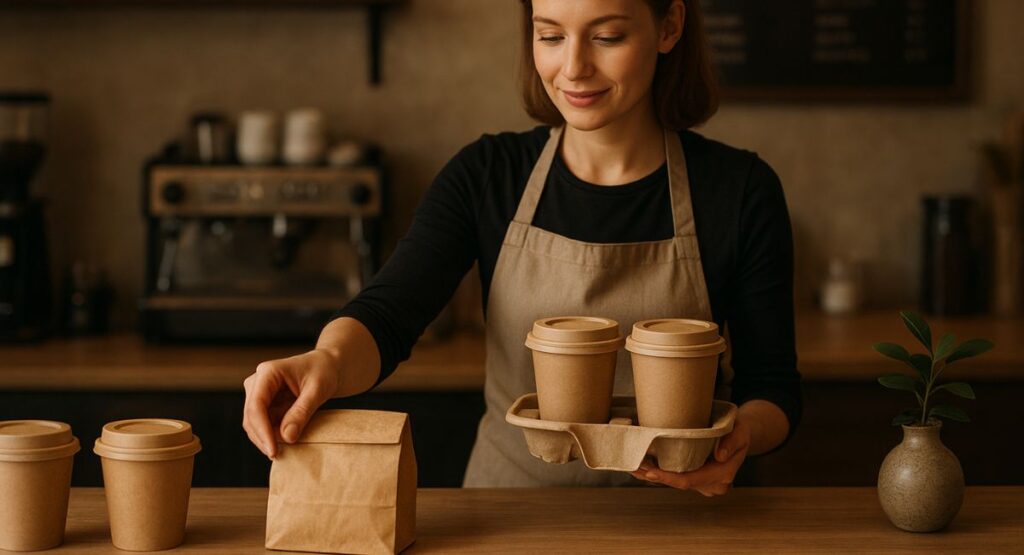
- The cafe of Berlin switched lids made of plastic to the pappedeckel during summer. Initially, a handful of customers complained of “weakness” near condensation. However, the cafe responded by switching to the lighter-coated version. As time passed, customers started applauding the new design, and the cafe noticed a reduction in the cost of plastic waste (and favorable social media posts).
- A craft fair vendor who made it himself utilized pappedeckel scraps to make the basis for jewelry boxes. People were awestruck and frequently brought a lid home to use as a souvenir and increased awareness of the eco-friendly potential of the product.
- A campaign on the internet created unique QR codes for every lid. If scanned, the code was a short video that demonstrates how the lid is reused. The campaign became viral and proved that even an item of a small size can be a powerful one. the message of a large scale.
These stories illustrate the ways that pappedeckel can be a part of narratives about brands, daily usage, and even community involvement.
Step-by-Step: How to Prototype Your Own Pappedeckel
For those who are an small business, student, or DIY enthusiast who wants to test a pappedeckel, here’s a basic guide to prototyping:
| Step | What You Need | What to Do | Tips / Notes |
| 1 | Paper or cardboard | Make a circular or rectangular cutout slightly bigger than the its rim | Allow a little room to allow for the possibility of overlap |
| 2 | Pencil and Compass (or template) | Make a sketch of the shape, using the margin to create an edge | The rim may assist the lid to “grip” the container |
| 3 | Scissors, or a utility knife | Cut the shape in a careful manner | Cut with a mat for precise cutting |
| 4 | A light coating (optional) | Apply a fine biodegradable water-resistant layer (e.g. Chitosan, chitosan, PLA dispersion) | Do not overcoat, as it could hinder recycling. |
| 5 | Branding / Decoration | Use food-safe ink or a stamp to include your design or logo | Limit printing to the minimum for recycling |
| 6 | Test of container | Set it on your cup/jar, and test the stability as well as fit and resistance | Explore different thicknesses and rim overlaps |
| 7 | Refine and iterate | Modify the shape, rim depth or the material to suit your needs | Get feedback from users |
When your prototype is working well and you are satisfied, you can go to an in-house printer or a packaging supplier to make an order.
Applications & Use Cases
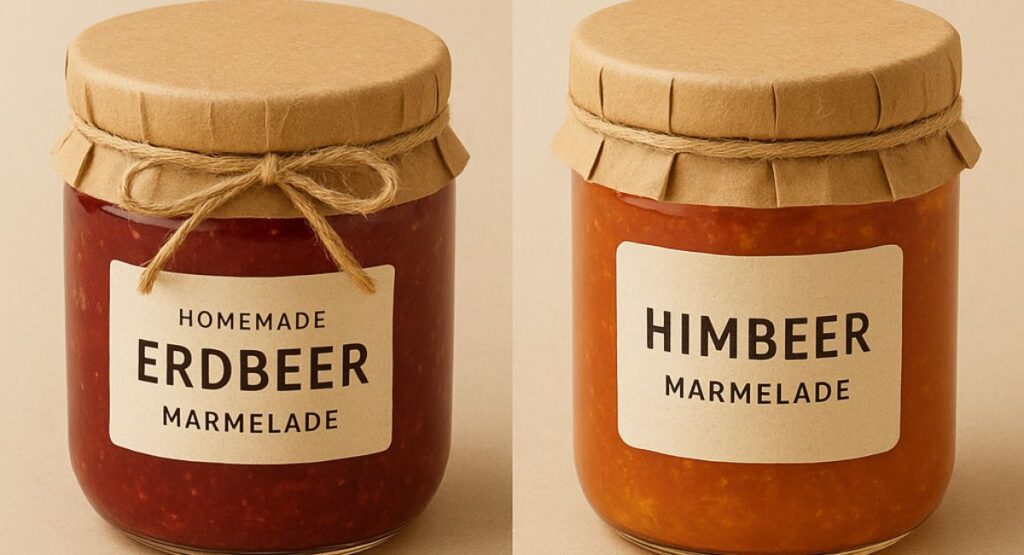
- Cafes & Restaurants
Cover hot soups, drinks and takeaway bottles. They are a great way to reduce plastic waste and also align with eco-friendly branding. - Jars, Bottles & Products
Use them for flat seals or as protective covers for honey jars sauces, jars of honey, or dry products. They provide a lightweight barrier and a branding surface. - Retail Packaging
In the world of e-commerce, pappedeckel may be used as covers for internal use or as divider layers within boxes. - Crafts & Education
As we’ve learned, unused lids can turn into art canvas coasters, tags, or other DIY items for artists and students. - Events & Promotions
The pappedeckel that is custom-printed can serve as promotional items or as interactive brand materials particularly in cases where QR codes and brief messages are added to.
Challenges & How to Overcome Them
While pappedeckel is promising, they do have issues:
- Moisture / Heat Vulnerabilities
A lot of exposure to condensation or steam can cause the lid to weaken.
Solution: Choose a light biodegradable coating or opt for the paperboard grade that has better wet strength. - Limited Reusability
As opposed to silicone lids or plastic the cardboard lid is usually used for one-time use.
Solution: Embrace recycling, design to encourage compostability or make the lid an integral part of a circular design. - Consumer Perception
Some users may doubt durability.
Solution: Provide side-byside comparisons, demonstrations or a the possibility of a limited guarantee to increase confidence. - Cost of Innovation
The research of new coatings or materials might require investments.
The solution is to start small, or work with sustainable packaging companies Many innovations are currently co-created. - Recycling Complexity
Certain recycling systems in the local area may not be able to separate coated paper properly.
Solution: Only use coatings that can be recycled in local streams of recycling paper and include disposal instructions on the lid.
If you can recognize and address these issues, companies can more effectively adopt pappedeckel-based solutions.
Trends, Innovation, and the Future
- Smart Packaging Integration
As previously mentioned in the previous paragraph, QR codes and NFC tags printed on paper lets consumers scan their device to view sourcing information instructions for recycling, promotional websites. - Biodegradable Coatings & Inks
New research is developing coatings made from algae, chitosan, and starch-based blends that make lids more resistant to moisture, but not affecting recycling. - Shape Innovations
Fold-out lids that fold down or collapse and snap-on lids, as well as lids with domed tops are appearing in the form of prototypes that can better manage various containers. - Legislation & Regulation Push
As more municipalities prohibit single-use plastics and other products, alternatives like pappedeckel gain regulatory support. Companies that are early adopters could be able to gain an advantage. - Circular Economy Systems
Some companies are offering lid return plans or compost collection services. The lid doesn’t simply become garbage, it transforms into an energy source.
SEO & Semantic Keywords to Help You Search
Some good terms to research (or incorporate into your content) include:
- sustainable packaging
- biodegradable lid
- Alternative lid for cardboard
- compostable packaging solutions
- Food packaging that is sustainable and eco-friendly
- Paperboard lids for cups
- Recycling cardboard lids for containers
- smart packaging QR lids
Utilizing these in conjunction with pappedeckel in your writing will help to reinforce relevance and the semantic context.
Conclusion
The pappedeckel might seem like an insignificant object however it holds huge implications. From creating sustainable packaging, to acting as an ideal branding surface, and even fostering the community This “cardboard lid” embodies the concept that small adjustments can have ripple effects.
In the case of a café artist or brand owner, or a environmentalist, then the idea of experimenting with or implementing the pappedeckel method could be a significant step towards improving your waste reduction and strengthening the brand’s story. Even if you only consider it the when you open your lid on your coffee–you’re celebrating the power of creativity within everyday design.
Want to learn more? Visit our blog for more helpful and informative articles.
FAQs
What is a Pappedeckel?
A Pappedeckel is a small cardboard lid used for cups, jars, and containers, designed to be eco-friendly and recyclable.
Where can Pappedeckel be used?
They’re used in food packaging, beverages, cosmetics, crafts, and branding.
Are Pappedeckel lids customizable?
Yes, they can be printed with logos, QR codes, or eco messages.
What materials are used to make Pappedeckel
They’re made from cardboard, recycled fibers, and eco-friendly coatings.
What are the benefits of using Pappedeckel lids?
They’re eco-friendly, lightweight, durable, cost-effective, and customizable.
How are Pappedeckel lids manufactured?
Cardboard is cut, coated, printed, and shaped into eco-friendly lids

I’m SEO expert and content writer at SEO Guest Pro.
I help websites rank higher, get more traffic, and grow fast using smart SEO and engaging content.
Let’s grow together!

